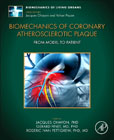
Biomechanics of Coronary Atherosclerotic Plaque: From Model to Patient
Ohayon, Jacques
Finet, Gerard
Pettigrew, Roderic
INDICE: Part 1: Biology, Physiopathology, Hemodynamics, Myogenic Responses and Clinical Intravascular Imaging of the Coronary Vascular Wall 1. Biomechanical Regulation of Endothelial Function in Atherosclerosis 2. Molecular mechanisms of the vascular responses to hemodynamic forces 3. Advanced atherosclerotic plaques in animal models versus human lesions: key elements to translation 4. Modeling the Glagov's compensatory enlargement of human coronary atherosclerotic plaque 5. Measuring coronary arterial compliance and vasomotor response in clinical and research settings 6. Coronary intravascular ultrasound and optical coherence tomography imaging and clinical contexts in coronary hemodynamics 7. The interaction of biochemical, biomechanical and clinical factors of coronary disease: review and outlook Part 2: Modeling Blood Flow in Arterial Branches and Bifurcations 8. Local blood flow parameters and atherosclerosis in coronary artery bifurcations 9. Effect of regional analysis methods on assessing the association between wall shear stress and coronary artery disease progression in the clinical setting 10. Hemodynamic disturbance due to serial stenosis in human coronary bifurcations: A computational fluid dynamics study 11. Hemodynamic perturbations due to the presence of stents 12. A new reduced-order model to assess the true fractional flow reserve of a left main coronary artery stenosis with downstream lesions and collateral circulations: an in vitro study Part 3: Fluid-Structure Interaction, Stress Distribution and Plaque Rupture in Arterial Wall 13. In vitro, primarily microfluidic models for atherosclerosis 14. Prediction of the coronary plaque growth and vulnerability change by using patient-specific 3D FSI models based on intravascular ultrasound and optical coherence tomography follow-up data 15. Atheromatous plaque initiation and growth: a multiphysical process explored by an in-silico mass transport model 16. Emergent biomechanical factors predicting vulnerable coronary atherosclerotic plaque rupture 17. Microcalcifications and plaque rupture 18. Identification of coronary plaque mechanical properties from ex-vivo testing 19. Importance of residual stress and basal tone in healthy and pathological human coronary arteries Part 4: Imaging Inflammatory Biomarkers for in vivo Intravascular Plaque Characterization 20. Intravascular ultrasound imaging of human coronary atherosclerotic plaque: novel morpho-elastic biomarkers of instability 21. Magnetic resonance elastography for arterial wall characterization 22. Noninvasive ultrafast ultrasound for imaging the coronary vasculature and assessing the arterial wall's biomechanics 23. Pulse wave imaging for the mechanical assessment of atherosclerotic plaques Part 5: Stenting, Coated Balloon, Drug Elution Systems and Modelling 24. Structure-function relation in the coronary artery tree: theory and applications in interventional cardiology 25. Sequential technique for the stenting of a coronary bifurcation: the re-proximal optimizing technique strategy 26. Modeling the stent deployment in coronary arteries and coronary bifurcations 27. The coated balloon protocol: An emergent clinical technique 28. Endovascular drug delivery and drug-elution systems
- ISBN: 978-0-12-824047-2
- Editorial: Academic Press
- Encuadernacion: Cartoné
- Páginas: 714
- Fecha Publicación: 27/03/2020
- Nº Volúmenes: 1
- Idioma: Inglés
